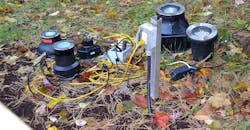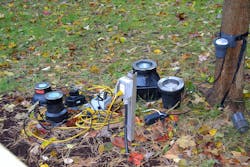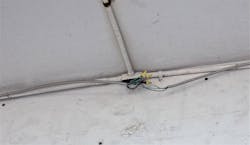All references are based on the 2017 edition of the NEC.
This Bursts My Bubble
The cover on this receptacle box has a few problems. First, it is not meant to be installed vertically with the cover flipping open to the side. It is designed to be installed horizontally with the cover flipping up. When used correctly, this enclosure would be weatherproof when the cover is closed. Not following instructions included with a listed product is a violation of Sec. 110.3(B). Secondly, it is not weatherproof while the attachment plug is inserted. Section 406.9(B)(1) requires this outdoor wet location receptacle enclosure to be weatherproof while in use. A “bubble cover” would have been a better option here. Section 406.9(B)(1) also requires any outlet box hood used for this purpose to be listed and identified as “extra duty.” That same Section also requires 15A or 20A, 125V and 250V receptacles installed in wet locations to be listed and identified as weather-resistant type receptacles. The liquidtight flexible metal conduit (LFMC) connected to the box is not properly secured within 12 in. of the box as required by Sec. 350.30(A). Section 350.10(3) permits LFMC to be used for direct burial applications where the LFMC is listed and marked for direct burial.
Messy MC Cable Installation
Whoever installed these MC cables was apparently looking to take the easy way out. They used cable ties to secure the MC cables to an existing PVC conduit instead of installing a new raceway or independently supporting the MC cables. Using a raceway to support cables is a violation of Sec. 300.11(C), unless the raceway is identified as a means of support. Section 352.12(B) also prohibits the PVC conduit from supporting any equipment other than conduit bodies as described in Sec. 352.10(H). The installer also yanked the cover off the PVC conduit body to splice the conductors in the raceway with the conductors of the MC cables. Section 300.15 requires a box or conduit body to be used when splicing or terminating conductors in MC cables. The lack of a box or enclosure for these splices creates a violation of Sec. 300.12, since there is no electrical continuity between the metal cable jackets of the MC cables. The lack of a cover for the conduit body is a violation of Sec. 314.25. Lastly, the lack of any fittings on the ends of the MC cable could leave sharp edges able to damage the insulation of the contained conductors and could be considered a violation of Sec. 300.4.
About the Author

Russ LeBlanc
Owner
Russ started in the electrical trade as an apprentice in 1985. He worked his way up to become a Journeyman Electrician and then eventually became a Master Electrician and Licensed Construction Supervisor. In 1999 Russ become an Electrical Instructor for The Peterson School of Engineering in Massachusetts where he developed his passion for teaching, and quickly became Department Head of Electrical Instruction. Russ has taught thousands of apprentices, electricians, engineers, inspectors, and other electrical professionals during his career as an instructor. He continues to provide electrical professionals with Electrical Code seminars, Arc-Flash Awareness training seminars and educational material through his LeBlanc Consulting Services in North Reading, MA whose specialty is educating electricians. He has been an active member of the NFPA Electrical Section and has authored hundreds of National Electrical Code proposals and comments which have become Code rules to improve the safety for the electrical industry. Russ is also an IAEI certified Electrical Inspector.
Please visit www.russleblanc.net for more information.


